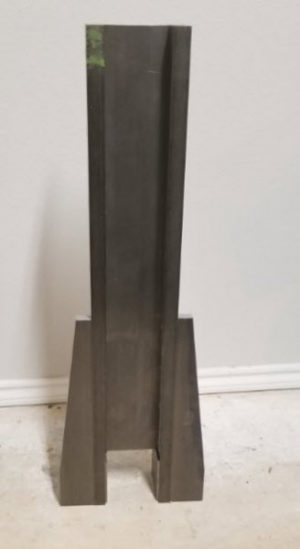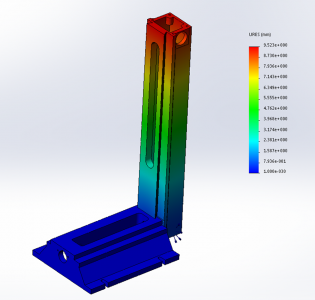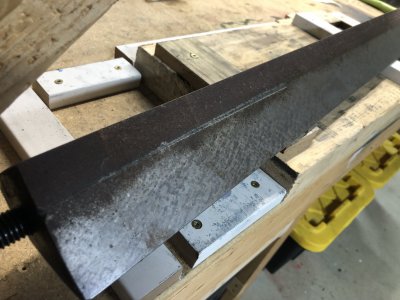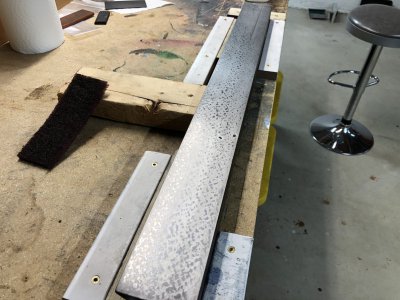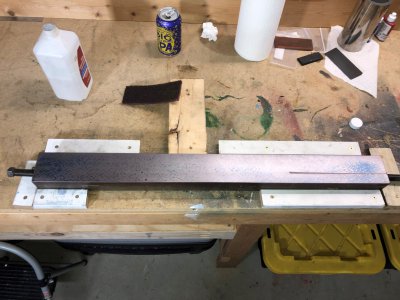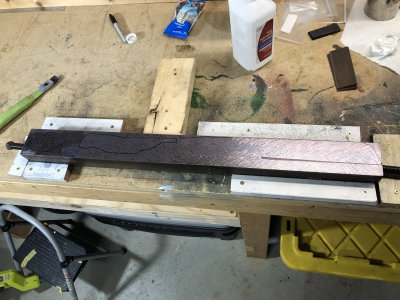- Joined
- Mar 26, 2018
- Messages
- 2,724
Mill Column Reinforcement:
My testing made it clear to me that the column of this machine is the most anemic component in terms of total loop stiffness between the tool and the workpiece. This definitely falls in the realm of experimentation, but I'm somewhat excited to give it a try.
I have purchased a 29" cut of 6" x 18# MC steel channel. This is 6" wide, 3.5" deep on the walls. The wall thickness is just shy of 1/2" and the back wall is .397" thick. The channel weighs 18 lbs per foot. MC channel stands for Miscellaneous Channel and is preferred over C or U channel because it has parallel walls and is extra deep. This cost about $150 shipped
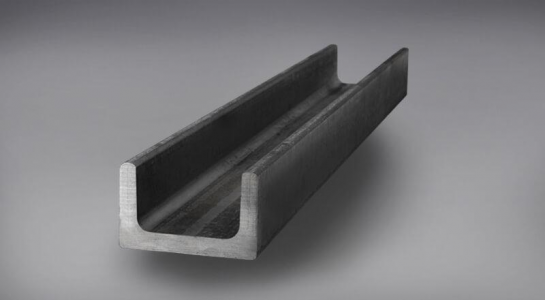
I plan to bolt this to the rear of the column, shimming to reduce any stress caused by the bolted connection. The inside walls of the MC channel and the outside of the column will be covered in many dozens of studs (perhaps short cap screws) to increase the surface area, and finally the void between the column and the channel filled with concrete (roughly 1/2" on all sides). I considered epoxy granite for the fill, however the cost (over $200 for epoxy alone) and the complexity of getting the proper aggregate made me stop considering the option. I may epoxy coat the inside of the channel and outside of the column in epoxy and sand to help the concrete bond to the surfaces. I would like to find some portland expanding cement which is touted to not shrink during curing and would ideally pre-tension the structure. Home Depot has Quikrete non-shrink precision grout for $16 a bag. Not bad!
Here is a view of the assembly cross section. The red represents the concrete fill. The channel is fairly narrow, so aggressive vibratory action will be needed to permit the concrete to flow properly.
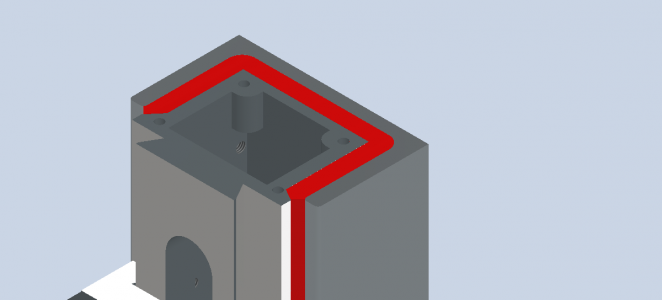
The side walls will not be bolted to the column to reduce stresses and deformation of the original column and precision surfaces. The interference between the concrete and studs on the column will provide most of the structural strength.
A front view shows the increase in column thickness from roughly a 4" box section with a 5" face to a 6" box. This also shows the 12x18x3 granite surface plate which will become an integral machine member both for precision alignment and rigidity.
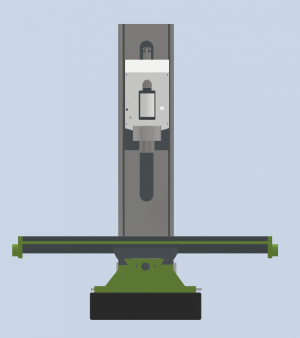
The rear of the column reinforcement will include access holes to attach the existing column to the base casting via 4 bolts, as well as some sort of beefy right angle brackets to rigidly fasten the column to the surface plate and tram the column for alignment. These brackets are not a final design.
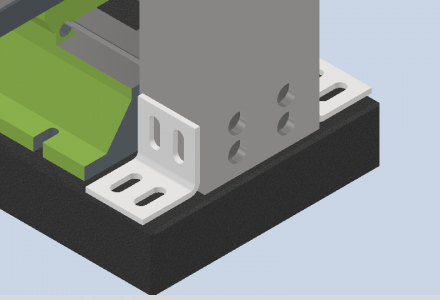
When fully cured the way surfaces will be precision scraped.
This modification will take the mass of the column from 47lbs to 103lbs and the cross sectional area from 6.9 in^2 to 17.8 in^2. I don't believe the vibration damping properties of concrete match that of cast iron or epoxy concrete, however it should offer some benefits in that regard.
To facilitate scraping, three cast iron pads will be attached permanently to the rear of the column and scraped to create a 3 point planar kinematic mount. These will be scraped until the flat ways are as level as can be, then they will be referenced as a check surface against which the flat ways, mounting face, and dovetail ways will be scraped.
The column reinforcement will interfere with the existing cable chain and gas strut counterweight for the head and spindle, as well as all the column mounted hardware like the drawbar solenoid and computer mounting arm. These will need to be reattached to the MC channel.
Please give me some feedback on this idea! Channel has already been ordered so I’m trying this in one form or another.
EDIT:
Here is a revised concept for the column attachment using a pair of 3x3x3" ground cast iron universal angle plates from KBC tool. They would be bolted both to the granite and the column with some substantial bolts and torqued tight after the column is fully aligned/trammed in the X direction. These represent a lower cost way to reinforce the column without significant expenditure or custom machining.
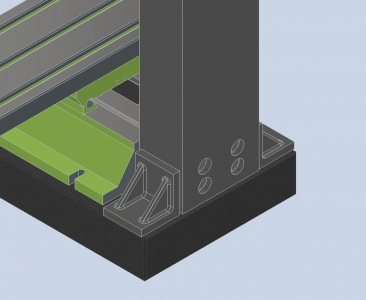
My testing made it clear to me that the column of this machine is the most anemic component in terms of total loop stiffness between the tool and the workpiece. This definitely falls in the realm of experimentation, but I'm somewhat excited to give it a try.
I have purchased a 29" cut of 6" x 18# MC steel channel. This is 6" wide, 3.5" deep on the walls. The wall thickness is just shy of 1/2" and the back wall is .397" thick. The channel weighs 18 lbs per foot. MC channel stands for Miscellaneous Channel and is preferred over C or U channel because it has parallel walls and is extra deep. This cost about $150 shipped

I plan to bolt this to the rear of the column, shimming to reduce any stress caused by the bolted connection. The inside walls of the MC channel and the outside of the column will be covered in many dozens of studs (perhaps short cap screws) to increase the surface area, and finally the void between the column and the channel filled with concrete (roughly 1/2" on all sides). I considered epoxy granite for the fill, however the cost (over $200 for epoxy alone) and the complexity of getting the proper aggregate made me stop considering the option. I may epoxy coat the inside of the channel and outside of the column in epoxy and sand to help the concrete bond to the surfaces. I would like to find some portland expanding cement which is touted to not shrink during curing and would ideally pre-tension the structure. Home Depot has Quikrete non-shrink precision grout for $16 a bag. Not bad!
Here is a view of the assembly cross section. The red represents the concrete fill. The channel is fairly narrow, so aggressive vibratory action will be needed to permit the concrete to flow properly.

The side walls will not be bolted to the column to reduce stresses and deformation of the original column and precision surfaces. The interference between the concrete and studs on the column will provide most of the structural strength.
A front view shows the increase in column thickness from roughly a 4" box section with a 5" face to a 6" box. This also shows the 12x18x3 granite surface plate which will become an integral machine member both for precision alignment and rigidity.

The rear of the column reinforcement will include access holes to attach the existing column to the base casting via 4 bolts, as well as some sort of beefy right angle brackets to rigidly fasten the column to the surface plate and tram the column for alignment. These brackets are not a final design.

When fully cured the way surfaces will be precision scraped.
This modification will take the mass of the column from 47lbs to 103lbs and the cross sectional area from 6.9 in^2 to 17.8 in^2. I don't believe the vibration damping properties of concrete match that of cast iron or epoxy concrete, however it should offer some benefits in that regard.
To facilitate scraping, three cast iron pads will be attached permanently to the rear of the column and scraped to create a 3 point planar kinematic mount. These will be scraped until the flat ways are as level as can be, then they will be referenced as a check surface against which the flat ways, mounting face, and dovetail ways will be scraped.
The column reinforcement will interfere with the existing cable chain and gas strut counterweight for the head and spindle, as well as all the column mounted hardware like the drawbar solenoid and computer mounting arm. These will need to be reattached to the MC channel.
Please give me some feedback on this idea! Channel has already been ordered so I’m trying this in one form or another.
EDIT:
Here is a revised concept for the column attachment using a pair of 3x3x3" ground cast iron universal angle plates from KBC tool. They would be bolted both to the granite and the column with some substantial bolts and torqued tight after the column is fully aligned/trammed in the X direction. These represent a lower cost way to reinforce the column without significant expenditure or custom machining.

Last edited:


